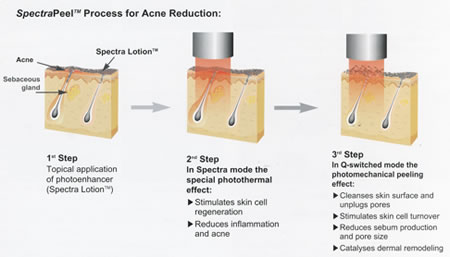This is an article from Dr Christopher Ng on the Spectra VRM III Laser Treatment combined with Omnilux LED Phototherapy.
What is a Spectra VRM III Laser Treatment?
Spectra VRM III is a CE and FDA approved non-ablative laser used in the treatment of many aesthetic conditions. Its advantages of being non-ablative means that it delivers the benefits of much more aggressive procedures
- without the discomfort and downtime
- patients return to their normal lives immediately after treatment
- improved patient satisfaction
When would you need the spectra laser treatment?
This treatment is recommended for people who have:
- Inflammatory Acne
- Enlarged Pores
- Fine Wrinkles
- Oily Skin
- Post Inflammatory Hyperpigmentation (PIH)
- Pigmented lesions
- Melasma (soft laser peel + laser toning)
- Unwanted tatoos (black, blue, brown, red, tan, purple, orange)
Advantages of Spectra VRM III Laser Treatment
- This Spectra laser treatment avoids prolonged downtime and PIH (post inflammatory hyperpigmentation) – common with AHA / TCA chemical peels and ablative CO2 lasers.
- It can also be used in combination with Vit C iontophoresis, LED phototherapy, microdermabrasion, RF, IPL or fractional laser therapy for better outcomes
Mode of Action
Spectra mode
- photothermal stimulation of the epidermis and dermis
- gently heats the microfine carbon particles in the SpectraLotion™ and exfoliates the outermost layer of the skin

Q-switched mode
- photomechanical destruction of the microfine carbon particles in the SpectraLotion™ along with removal of outermost layer of dead skin
- skin tone and texture are improved
- cells associated (fibroblasts, mast cells, macrophages) with skin rejuvenation are stimulated resulting in collagen remodelling
Spectra Laser Treatment Procedure (for enlarged pores, acne scars, active acne, fine wrinkles)
- Face is washed and cleaned
- Topical anaesthetic cream is applied (20mins to take effect)
- SpectraLotion™ containing fine carbon particles is applied thinly and evenly onto the face
- Fine carbon particles penetrate into the pores and acne scars
- 1st laser pass in Spectra mode penetrates deep into the dermis which has a photothermal effect, stimulates skin cell regeneration and exfoliates the outermost layer of skin (stratum corneum)
- 2nd pass in Q-switched mode causes explosion of the fine carbon particles which has a photomechanical effect, exfoliates the outermost layer of skin (stratum corneum), shrinks pores, reduces sebum production to reduce acne, stimulates collagen remodelling, penetrates deep into dermis fracturing melanin that causes uneven pigmentation and stimulates natural phagocytosis processes to remove the unwanted colouration. All resulting in cleaner younger looking skin.
Spectra Laser Treatment Procedure (for pigmentation and tattoo removal)
- Face is washed and cleaned
- Topical anaesthetic cream is applied (20mins to take effect)
- The laser energy is focused directly onto the pigment or tattoo
- The pigment is fractioned and broken down into tiny particles by the laser energy without damaging the surrounding skin allowing cells in your body to naturally digest and dispose of the tiny pigment or ink particles
2) Post Treatment Omnilux LED Phototherapy
Omnilux LED phototherapy (lights-only) is an FDA approved procedure used to enhance and improve skin treatments (after Botox®, fillers, facial peels, microdermabrasion, lasers and IPL therapy).
Advantages
- It reduces side effects and speeds up the regeneration time.
- Painless
- You will have LED Revive phototherapy at 633nm (red light) for 20 minutes
- stimulates fibroblast
- faster and more efficient collagen synthesis
- stimulates regeneration and wound healing
Post Treatment Skin Care
- Use Quick Recovery Lotion to reduce redness and downtime
- At least SPF 30 UVA + UVB Sunblock to reduce post laser pigmentation
- Post Treatment Mask at night for added radiance and moisture
- Facial wash, Vit C serum, Rejuvenation cream & Anti-pigment cream
Treatment Interval
- 3 weekly
- Complete treatment package of 5 sessions
- Maintenance 1x session every 3 months
Possible Complications (when energy levels are too high)
- Temporary redness – subsides within a few hours
- Burns – reduced if you adhere to post treatment regime
- Scaring (excessive dermal damage) – much less with non-ablative lasers
- Post inflammatory hyperpigmentation (temporary for 3-4 months) (avoid the sun, use sunblock, anti-pigment cream, more common in darker skin types)
- Hypopigmentation (temporary or permanent) – more common in darker skin types
- Blistering (excessive epidermal thermal damage) – reduce with cooling ice to protect epidermis
- Dry skin – reduced if you adhere to post treatment regime
- Skin allergy (occasionally in tattoo removal, reaction to fragmented tattoo pigments, topical anti-histamine cream)
Dr Christopher Ng practices at GynaeMD Women’s & Rejuvenation Clinic, located in Camden Medical Center Singapore, which offers obstetric, gynaecology and aesthetic services in Singapore.
Want to get more articles from 40+style in your inbox, subscribe here.
You can also connect with 40+style on Facebook, Instagram or Pinterest.
Support 40+style by using the links in our articles to shop. As an associate for Amazon and many other brands, we receive a small commission (at no cost to you) on qualifying purchases which enables us to keep creating amazing free content for you. Thanks!

